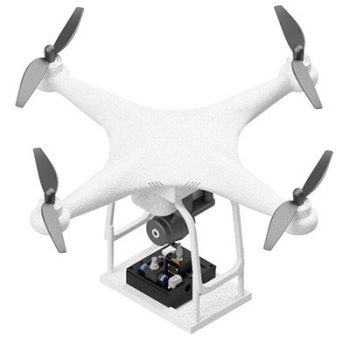Continuous, precise monitoring is the first step in mitigating the effects of air pollution, which can lead to the onset of asthma and other diseases. The majority of measurement equipment is fixed and just a few feet above the ground, yet pollutants can migrate. Now, scientists have created a “lab-on-a-drone” system that, unlike previous devices, can detect and analyze levels of contaminants, such as smelly hydrogen sulfide gas, while still floating in midair. Their findings were published in the ACS journal Analytical Chemistry.

This modified quadcopter drone can detect and analyze hydrogen sulfide gas while in the air. Image Credit: Adapted from Analytical Chemistry, 2023, DOI: 10.1021/acs.analchem.3c02719
One of the most easily-smelt air pollutants, hydrogen sulfide (H2S), is well known for its foul, rotten-egg smell. It is a common byproduct of petroleum refineries and wastewater treatment facilities despite being naturally occurring in well water and volcanic eruptions. The gas is irritant, and in large enough quantities, it could be toxic.
The majority of methods for detecting H2S and other contaminants rely on ground-based detectors, and costly devices such as satellites are necessary to take readings at higher altitudes. Researchers deployed unmanned drones to collect samples in mid-air, but examinations had to be done on the ground with standard tools.
So João Flávio da Silveira Petruci and colleagues set out to build a low-cost “lab-on-a-drone” capable of sampling and analyzing H2S gas in the air and reporting the results in real time—a first for devices of this type.
Using a 3D printer, the team created a unique gadget that was attached to the bottom of a commercially available quadcopter drone. It makes use of a unique chemical interaction between H2S and a green-glowing fluorescein mercuric acetate molecule.
When activated by an onboard blue LED light, the contact generated a drop in green fluorescence intensity, which was observed and quantified. This selective reaction was unaffected by other interfering gaseous air contaminants.
The researchers flew their drone to a wastewater treatment plant, where it sampled air on the ground and then at 30 and 65 feet in the air three times throughout the day. The detecting equipment sent its findings to a smartphone via Bluetooth, enabling real-time monitoring.
In the evening, the H2S concentration grew clearly as the drone climbed altitude, although it never surpassed the permissible ambient level. According to the researchers, this technology might be modified in the future to identify different contaminants.
The Coordination for the Improvement of Higher Education Personnel, the Research Support Foundation of the State of Minas Gerais, and the National Council for Scientific and Technological Development provided support to the authors.
Journal Reference
Leal, V. G., et al. (2023) AirQuality Lab-on-a-Drone: A Low-Cost 3D-Printed Analytical IoT Platform for Vertical Monitoring of Gaseous H2S. Analytical Chemistry. doi:10.1021/acs.analchem.3c02719